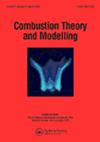A dynamic load balancing model coupled with DAC and ISAT for a stochastic turbulent combustion model
IF 1.6
4区 工程技术
Q4 ENERGY & FUELS
引用次数: 1
Abstract
Due to the composition-dependent stiffness of chemistry, simulations of reactive turbulent flows may present computational load imbalance among parallel processes when spatial decomposition is used for parallelisation, causing high CPU idle time and waste of computational resources. To increase computational efficiency, a dynamic load balancing (DLB) model is proposed to redistribute computational load among computing cores. The DLB model exploits a decomposition in the mixture fraction space with two dynamic adjusting decomposition strategies to realise load redistribution. The DLB model is suitable for the integration of chemistry on stochastic particles in hybrid Eulerian/Lagrangian turbulent combustion models in which the Eulerian field is conventionally decomposed statically in physical space in a way that balances the computational load for the solution of the Navier-Stokes equation but which does not generally lead to balanced load for the computation of the composition fields. Here it is tested using an OpenFOAM-based platform, mmcFoam, which is a comprehensive object-orientated C++ library for stochastic turbulent combustion modelling. Apart from direct integration (DI) for chemistry, the DLB model is also coupled with dynamic adaptive chemistry (DAC) and in situ adaptive tabulation (ISAT), which allows for extra speedup. The performance of the coupled models is validated and assessed for two laboratory flame conditions that exhibit different levels of computational load imbalance. Overall, the DLB model effectively balances the computational load distribution and increases the effective usage of computing power, shortening the simulation wall time required. Moreover, a strong scaling test is carried out using up to 512 cores. Although all approaches have sub-ideal scalability, the scalability of each with DLB is significantly better than without DLB. While DLB-ISAT has relatively poor scalability compared to the DI- and DAC-based methods, DLB-ISAT still ranks the fastest among the algorithms in all scaling trials.随机湍流燃烧模型的DAC和ISAT耦合动态负载平衡模型
由于化学的成分依赖刚度,当使用空间分解进行并行化时,反应性湍流的模拟可能会出现并行过程之间的计算负载不平衡,导致CPU空闲时间高,浪费计算资源。为了提高计算效率,提出了一种动态负载平衡(DLB)模型来重新分配计算负载。DLB模型利用混合分数空间分解和两种动态调整分解策略来实现负荷再分配。DLB模型适用于欧拉/拉格朗日混合湍流燃烧模型中随机粒子的化学积分,在该模型中,欧拉场通常在物理空间中静态分解,以平衡求解Navier-Stokes方程的计算负荷,但通常不会导致计算组成场的平衡负荷。在这里,使用基于openfoam的平台mmcFoam进行测试,mmcFoam是一个面向对象的综合c++库,用于随机湍流燃烧建模。除了用于化学的直接集成(DI)外,DLB模型还与动态自适应化学(DAC)和原位自适应制表(ISAT)相结合,从而实现了额外的加速。在两种具有不同计算负荷不平衡水平的实验室火焰条件下,对耦合模型的性能进行了验证和评估。总体而言,DLB模型有效地平衡了计算负载分布,提高了计算能力的有效利用率,缩短了仿真墙时间。此外,使用多达512个内核进行了强缩放测试。虽然所有的方法都具有次理想的可伸缩性,但是使用DLB的方法的可伸缩性都明显优于不使用DLB的方法。虽然与基于DI和dac的方法相比,DLB-ISAT的可扩展性相对较差,但在所有缩放试验中,DLB-ISAT仍然是算法中最快的。
本文章由计算机程序翻译,如有差异,请以英文原文为准。
求助全文
约1分钟内获得全文
求助全文
来源期刊

Combustion Theory and Modelling
工程技术-工程:化工
CiteScore
3.00
自引率
7.70%
发文量
38
审稿时长
6 months
期刊介绍:
Combustion Theory and Modelling is a leading international journal devoted to the application of mathematical modelling, numerical simulation and experimental techniques to the study of combustion. Articles can cover a wide range of topics, such as: premixed laminar flames, laminar diffusion flames, turbulent combustion, fires, chemical kinetics, pollutant formation, microgravity, materials synthesis, chemical vapour deposition, catalysis, droplet and spray combustion, detonation dynamics, thermal explosions, ignition, energetic materials and propellants, burners and engine combustion. A diverse spectrum of mathematical methods may also be used, including large scale numerical simulation, hybrid computational schemes, front tracking, adaptive mesh refinement, optimized parallel computation, asymptotic methods and singular perturbation techniques, bifurcation theory, optimization methods, dynamical systems theory, cellular automata and discrete methods and probabilistic and statistical methods. Experimental studies that employ intrusive or nonintrusive diagnostics and are published in the Journal should be closely related to theoretical issues, by highlighting fundamental theoretical questions or by providing a sound basis for comparison with theory.
 求助内容:
求助内容: 应助结果提醒方式:
应助结果提醒方式:


